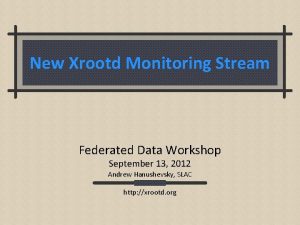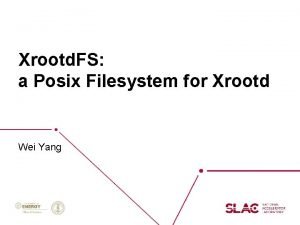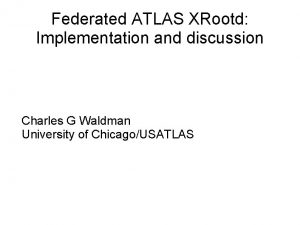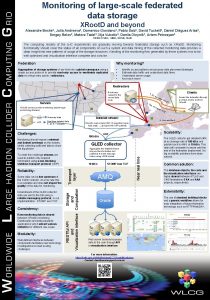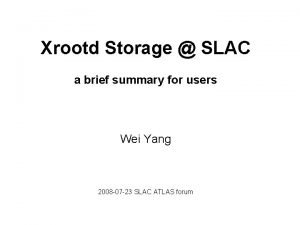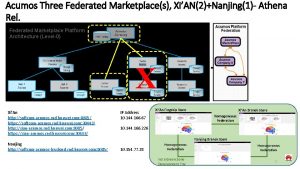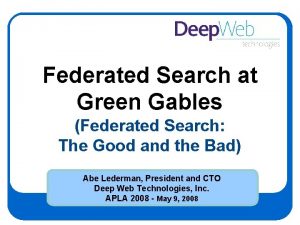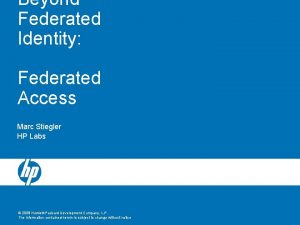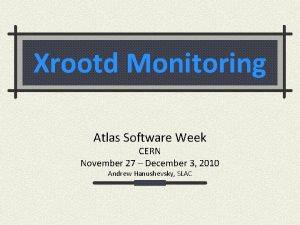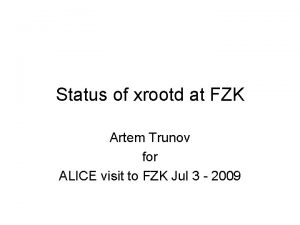XROOTD AND FEDERATED STORAGE MONITORING CURRENT STATUS AND



















- Slides: 19

XROOTD AND FEDERATED STORAGE MONITORING CURRENT STATUS AND ISSUES A. Petrosyan, D. Oleynik, J. Andreeva Creating federated data stores for the LHC CC-IN 2 P 3, Lyon, November 22, 2011

Outline • Historical overview • XRoot. D monitoring background • Use cases and user categories • Monitoring architecture of • Site • Federation • VO&WLCG • Issues • Conclusions

Historical overview Tier 3 monitoring task force Software suit to enable T 3 sites monitoring, two layers • T 3 mon site • Site infrastructure monitoring • Batch, storage software monitoring • Data representation via Ganglia monitoring system • T 3 mon global • Monitor T 3 site activity on global layer: data popularity, transfers • Data representation via Dashboard Special part of project: XRoot. D monitoring for site, federation monitoring as a part of T 3 mon global

XRoot. D monitoring background XRoot. D instrumented for monitoring • Summary stream • Overview of site health, easy to configure and represent • Detailed stream • Provides information about each single operation (authorization, staging, IO, etc. ) • Complicated to use: decoding and aggregation needed Every instance (server, redirector) uses same data transportation (UDP) and representation technology Combination of info from summary and detailed allows to feed site and federation monitoring

XRoot. D monitoring metrics • Following metrics provided and extracted: • File • Open/Close, Transferred volume, Read/Write • Username • Application • Trace • Client IP/name • Server IP/Name • This metrics can be used as initial aggregation patterns

Use cases Monitoring of the XRoot. D transfers and data access are required at various levels: • Site (administrators) • Federation (federation administrators) • VO (VO managers) • WLCG Different data should be presented on every level Different requirement for different user categories

Monitoring consumers & requirements • • • Health of sites • Transfers between sites • Redirections Easy integration Health of site Transfers to site Transfers from site • Data transfers • Consumed recourses • Health of sites (Co. S) Site Federation WLCG VO • VO data transfers • Health of sites • Data popularity

Architecture 1/2 • Information collected from servers/redirectors • All top level metrics are calculated or aggregated based on data coming from servers/redirectors • At the moment we do not have good estimation of how much data has to be handled on the federation level (depends on number of sites, type of messages, granularity, etc. ), but it is clear that solution should be scalable

Architecture 2/2

Architecture. Site monitoring 1/2 • Summary metrics are collected and represented through local fabric monitoring system • Ganglia solution is already implemented • Python parser for extracting metrics from detailed stream is ready • Plugin system for intercommunication with different backends: • Postgre. SQL for T 3 site • MSG for CMS popularity Both solutions have been implemented and are being tested • Transfer info available only via detailed stream • Lot of data • Scalability & load tests needed

Architecture. Site monitoring 2/2

XRoot. D monitoring through Ganglia http: //vm 01. jinr. ru/ganglia/? c=XRoot. D&h=vm 08. jinr. ru

Architecture. Federation monitoring 1/3 • Collecting filtered list of metrics at the site (servers/redirectors) • All data generated by servers at site level • Each site must be declared in the WLCG&VO topology • Transmitting data for aggregation (MSG/Active. MQ) to central storage • Scalability – queues with asynchronous operations and multiple consumers support

Architecture. Federation monitoring 2/3 • Central storage/Data aggregation alternatives: • RDBMS • Data normalization, logical complexity, high cost of any data structure change • Structured data storage (Hbase) • Scalable, flexible, fast access to data • Presentation & Visualization • JSON • Easy data integration within application and between web applications • Django, j. Query • Python, AJAX

Architecture. Federation monitoring 3/3

Architecture. VO&WLCG monitoring • Data collected from XRoot. D federations • Federation must be declared in the WLCG&VO topology • Applications must provide VO mark of user for transfer at the site level • Transfer of monitoring data (MSG/Active. MQ/Web. Service) • Integration with Dashboard • Data formats to be agreed

Architecture. VO monitoring

Issues • Federation topology • Site and federation declaration in the WLCG&VO topology • Metrics • Information is available, list of metrics for federation/VO/WLCG level to be agreed • Initial aggregation patterns

Conclusions • Monitoring architecture for XRoot. D data transfers on the local and global levels is being prototyped • Collection and publishing of basic metrics at the site level is implemented and is being tested • Technology and infrastructure for data transmission is in place • Technology for data aggregation and visualization is defined
 Secondary storage vs primary storage
Secondary storage vs primary storage Primary storage and secondary storage
Primary storage and secondary storage A balanced delta connected load having an impedance 20-j15
A balanced delta connected load having an impedance 20-j15 Phase to phase voltage
Phase to phase voltage Drift current and diffusion current in semiconductor
Drift current and diffusion current in semiconductor Line current and phase current
Line current and phase current Drift vs diffusion current
Drift vs diffusion current Drift current and diffusion current in semiconductor
Drift current and diffusion current in semiconductor In a triangle connected source feeding a y connected load
In a triangle connected source feeding a y connected load Holding current and latching current
Holding current and latching current Drift current density unit
Drift current density unit Reservoir storage monitoring system
Reservoir storage monitoring system Reservoir monitoring system
Reservoir monitoring system Uses rigid metallic platters
Uses rigid metallic platters Unified storage vs traditional storage
Unified storage vs traditional storage Pinch off voltage
Pinch off voltage The major classifications of welding machines are ____.
The major classifications of welding machines are ____. Hazard based safety engineering
Hazard based safety engineering Non planar circuit
Non planar circuit Wg status monitoring service
Wg status monitoring service




















